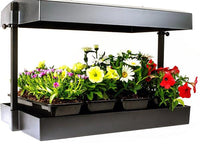Powdery mildew is one of the top destroyers of grows. Humid environments are most vulnerable, but this menace invades indoor and outdoor plants in deserts, too.
Stick around, and we’ll teach you how to prevent and remove powdery mildew infections so you won’t have to worry about your indoor plants getting ruined.
What is Powdery Mildew?
Powdery mildew is a fungus. It appears as white or gray powder-like blotches on leaves, stems, stalks, fruits, and flowers.
This killer doesn’t need free water to survive and thrive. It favors moderate to high humidity environments and low levels of light.
The Southeastern USA is home to large quantities of powdery mildew, but the low desert areas of Arizona also get their share of it.
Because it doesn’t like a lot of light shining on it, you may find it mostly on the lower parts of the plant.
Powdery mildew comes in different forms, each of which specializes in certain types of plants. One type invades only grapes, for example. Another invades melon and squash gardens.
As powdery mildew spreads, leaves may turn brown or yellow. Eventually, the plant may dry out and shrivel up. Flower production will slow down or stop.
On cannabis plants, you will probably first notice white blotches, and sometimes tiny white lines, on the leaves and/or branches. When taking a close look, you’ll see that they’re fuzzy. You may see the leaves wilting.
The fungus can strike during any stage of growth. It can even infect buds after harvest.
It sometimes appears as small blisters on leaves, especially leaf tops, before the fuzzy blotches develop.
How to Prevent Powdery Mildew from Infecting Indoor Plants
The best way to beat powdery mildew is to make sure it never reaches your plants in the first place.
Infestation is VERY common in home grows that don’t include proper prevention measures.
Prevention begins during the vegetative stage. You at least want to start the process well before mid-flower.
If powdery mildew strikes during mid-flower or late-flower, chances are you won’t be able to do diddlysquat about it. You might as well chop your girls down. But don’t give up hope. We’ll show you what you CAN do if it gets to that point.
Things you can do to prevent powdery mildew
Purify Your Air
Powdery mildew spreads through spores. A good filtration system will prevent mold spores and other pathogens.
A HEPA intake filter will decontaminate air coming into your grow room or tent. Some indoor growers use intake systems for the entire grow room. Others only do that for the tent itself. Either way, HEPA filtration will help keep the girls safe.
Check On Your Girls Daily If You Can
If your prevention techniques fail, you will need to spot the infection early. Check the tops and bottoms of all leaves and every square inch of each and every plant.
If you can do this daily, do it. Once even one plant is infected with powdery mildew, the infection will spread quickly through the whole plant and to other plants. The infection can spread from a tiny speck to a lot of white or gray blotches within the span of a few days.
Keep Your Pets Away From Your Indoor Plants
Dogs, cats, and other animals can carry spores, and the spores can go airborne. A more likely cause of infection is a pet with spores coming into direct contact with leaves and branches. Keep the door to the grow room closed.
People can contaminate your indoor plants, too. Only let people enter if they’re necessary for the grow. Spores can hitchhike on both fur and clothing.
Control Insects as Part of Your Powdery Mildew Prevention Strategy
Dogs, cats, and people aren’t the only creatures that can infect your plants. Insects can carry spores, too.
Neem oil is a natural plant-based fungicide that’s good at preventing invasions from both powdery mildew and insects.
Sesame oil is another good fungicide. Don’t buy the “toasted” kind, as that’s more expensive than standard sesame oil.
Diatomaceous earth is a powder coming from fossilized marine organisms called diatoms. When it makes contact with insects, it slices them up and they die from dehydration.
For a natural pesticide spray made from plants, we recommend FoxFarm’s Don’t Bug Me® Home and Garden Insect Spray. It contains pyrethrum. Pyrethrum kills insects quickly on contact and flushes out hiding insects. Once they’re flushed out, give ‘em a squirt. Keep pyrethrin away from fish, pets, and pollinators.
If you prefer neem, we recommend Dyna-Gro Super Clean Neem Cold Pressed Neem Seed Oil.
Keep Humidity Low in Your Indoor Grow Room or Tent
Powdery mildew thrives in environments with 55% humidity or higher.
Your indoor plants will have different humidity needs at different growing stages. During the vegetative stage, a relative humidity of 45% to 55% should be plenty. While flowering, you can lower the air humidity a bit more.
That’s just a rule of thumb, but following it will do a lot to prevent powdery mildew.
When it’s time for drying and curing, keep that room at a relative humidity between 45% and 55%.
You can maintain good control over the environment with air conditioners, fans, and dehumidifiers.
The Active Air 190 Pint Dehumidifier provides precise digital control over the humidity levels in your indoor grow room. It covers grow rooms as large as 12,900 cubic feet. It’s also easy to clean.
If you need something slightly smaller, try the Active Air 110 Pint Dehumidifier.
The Active Air 14,000 BTU Portable Air Conditioner is great for controlling temperature for up to 800 cubic feet of grow room space. It contains a smart system that works with all controllers and timers.
Use a Foliar Fungicide Spray
A foliar spray is a spray you apply to leaves and branches. It’s a good idea to spray your indoor plants at least weekly. There are chemical fungicide sprays and natural and organic sprays. Some are more toxic than others.
Make sure you have two or three foliar sprays that you can rotate.
If any spray you choose has the potential to cause leaf burn, test it on a small number of leaves for each strain first. Sensitivity varies by strain.
Another thing to remember is that the risk of leaf burn goes up when the grow lights are on. Treat your plants after the lights go out if you’re using anything that could burn them.
If you introduce new babies or clones to your grow, treat them thoroughly. If you can drench them, do so.
Warning: Some fungicide sprays will harm flower development, and some may become part of the flavor of the final product.
For a big list of commercial and DIY foliar sprays, skip to the “How to Treat & Kill Powdery Mildew” section below.
Use Circulating Fans & a Good Ventilation System
Make those leaves dance. It will keep spores from multiplying and from affixing themselves to your plants.
The 30W Monkey Fan v2.0 can be attached to almost any grow tent pole or PVC pipe. The height is adjustable, too.
Powdery mildew favors low ventilation, too, so make sure you have a good ventilation system.
Prune Your Plants
Powdery mildew favors dark areas with thick foliage. Pruning allows light to shine on the lower parts of the plants.
Don’t Overcrowd Your Grow
Powdery mildew loves crowded growing conditions. Don’t cram too many indoor plants in a small space. Make sure the leaves of one plant aren’t touching the leaves of the plants next to it.
Water Your Plants Long Before the Lights Go Out
You want the lights to shine on your indoor plants for at least five hours after you water them.
Clean Your Indoor Grow Room Between Growing Cycles
Before starting a new crop, give your room a good scrub down. This goes for your fans, lights, and other accessories, too. You can use a mixture of water and either hydrogen peroxide or bleach. Don’t mix those two chemicals.
How to Treat & Kill Powdery Mildew If It Infects Your Indoor Plants
The first thing you want to do is catch an infection early and remove all affected leaves and branches. You can use scissors for this.
The trick is to isolate all affected plant parts and unsalvageable whole plants without:
- Shaking up your plants & sending spores flying through the air
- Contaminating more plants & plant parts by touching them with sporey scissors, clothing or hands
Place all contaminated plant matter in plastic bags and keep the bags closed. When you’re done with each bag, seal it and bring it to an area that is far away from your grow. Outside is best. Better yet, keep them as far from the building as possible.
Use hand sanitizer frequently. Isopropyl alcohol will kill powdery mildew and its spores. Treat your scissors, too, with either hand sanitizer or isopropyl alcohol solution that is 70% or higher.
Once your indoor plants begin flowering, it’s much harder to save your girls. However, it’s still possible. Get rid of all infected buds, whether they become infected before harvest or while drying. Never smoke them, sell them, or give them away.
What to Do After Quarantining Infected Plant Parts
A lot of substances people use in foliar sprays to prevent powdery mildew can also be used for treating it. You may need to be more aggressive when using them after infection to make sure it doesn’t spread.
Neem or Sesame Oil Spray
Both of these oils are great for prevention and treatment. Add two teaspoons per gallon of water.
For extra benefits, you an add four teaspoons each of baking soda (or potassium bicarbonate, which is safer for plants) and liquid dish soap (not detergent).
Other good oils include fish oil and oils of cinnamon, clove, and coriander. Each may require a different amount in a water mixture, especially if they’re essential oils. Two teaspoons of cinnamon essential oil would be way too much for one gallon of water.
Grow Supply Shop carries Dyna-Gro Super Clean Neem Cold Pressed Neem Seed Oil. Insects cannot build resistance to this oil. Neither can fungi nor bacteria.
Potassium bicarbonate
Some people use sodium bicarbonate (baking soda) to prevent or treat powdery mildew and insects, but it can be dangerous to plants because of the sodium content. Of course, that depends on how much you use.
Potassium bicarbonate is a safer alternative. An additional benefit for the plants is that they absorb some of the potassium. Potassium is one of the “Big 3” macronutrients every grow needs.
You can make a nice foliar spray with four teaspoons of potassium bicarbonate, ½ teaspoon of liquid soap, and a gallon of water. This ratio is good for larger quantities, too, in case you have to scale.
If you do use baking soda, put it in water at a ratio of 2.5ml per liter. That’s about ½ teaspoon per quart and two teaspoons per gallon.
Milk & Water Spray
Some growers have good luck with a 60/40 mix of water and milk. The milk reacts with bright artificial light or sunlight, resulting in antiseptic chemicals that kill powdery mildew.
Limonene
Limonene is the degreasing agent found in citrus peels.
You can add a teaspoon of this stuff to a quart of water (or 5mL per liter).













